Top Rankings
Yukon Flats School District ranks among the top 20% of public school district in Alaska for:
Category
Attribute
Student Attention
Lowest student:teacher ratio (Top 1%)
For the 2025 school year, there are 7 public schools serving 190 students in Yukon Flats School District. This district's average testing ranking is 4/10, which is in the bottom 50% of public schools in Alaska.
Public Schools in Yukon Flats School District have an average math proficiency score of 22% (versus the Alaska public school average of 24%), and reading proficiency score of 22% (versus the 30% statewide average).
Minority enrollment is 97% of the student body (majority American Indian), which is more than the Alaska public school average of 53% (majority American Indian).
Overview
This School District
This State (AK)
# Schools
7 Schools
500 Schools
# Students
190 Students
130,460 Students
# Teachers
24 Teachers
7,187 Teachers
Student : Teacher Ratio
8:1
8:1
District Rank
Yukon Flats School District, which is ranked within the bottom 50% of all 53 school districts in Alaska (based off of combined math and reading proficiency testing data) for the 2021-2022 school year.
The school district's graduation rate of 50% has stayed relatively flat over five school years.
Overall District Rank
#45 out of 53 school districts
(Bottom 50%)
(Bottom 50%)
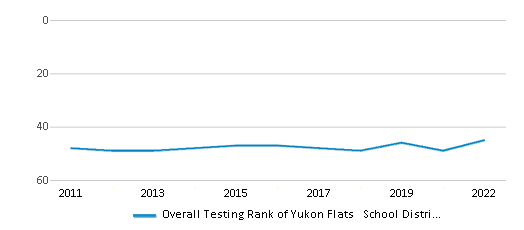
Math Test Scores (% Proficient)
≤5%
23%
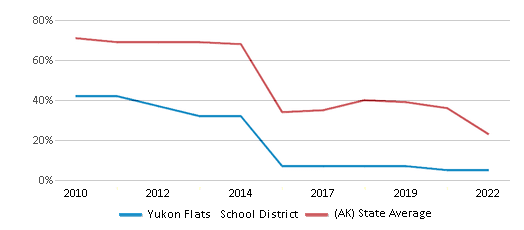
Reading/Language Arts Test Scores (% Proficient)
≤5%
29%
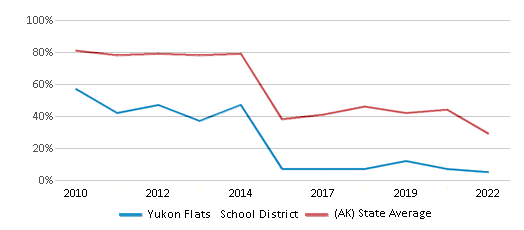
Science Test Scores (% Proficient)
≤10%
38%
Graduation Rate
≥50%
78%
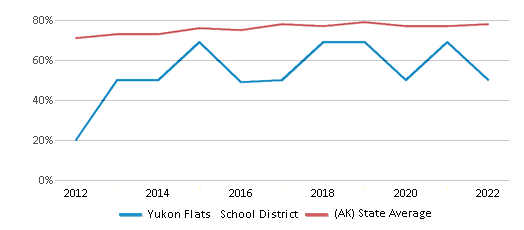
Students by Ethnicity:
Diversity Score
0.06
0.71
# American Indian Students
184 Students
28,192 Students
% American Indian Students
97%
22%
# Asian Students
n/a
6,424 Students
% Asian Students
n/a
5%
# Hispanic Students
n/a
9,991 Students
% Hispanic Students
n/a
8%
# Black Students
1 Student
2,947 Students
% Black Students
n/a
2%
# White Students
5 Students
61,102 Students
% White Students
3%
47%
# Hawaiian Students
n/a
4,122 Students
% Hawaiian Students
n/a
3%
# Two or more races Students
n/a
17,682 Students
% of Two or more races Students
n/a
13%
Students by Grade:
# Students in PK Grade:
6
3,308
# Students in K Grade:
13
9,246
# Students in 1st Grade:
14
9,690
# Students in 2nd Grade:
15
10,021
# Students in 3rd Grade:
10
9,773
# Students in 4th Grade:
17
9,936
# Students in 5th Grade:
6
9,837
# Students in 6th Grade:
20
9,754
# Students in 7th Grade:
16
9,643
# Students in 8th Grade:
19
9,623
# Students in 9th Grade:
14
10,140
# Students in 10th Grade:
13
9,935
# Students in 11th Grade:
14
9,806
# Students in 12th Grade:
13
9,748
# Ungraded Students:
-
-
District Revenue and Spending
The revenue/student of $50,584 is higher than the state median of $20,163. The school district revenue/student has grown by 8% over four school years.
The school district's spending/student of $59,111 is higher than the state median of $21,240. The school district spending/student has grown by 8% over four school years.
Total Revenue
$10 MM
$2,630 MM
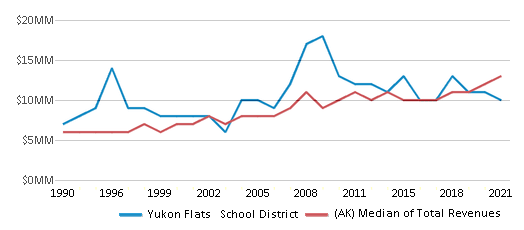
Spending
$11 MM
$2,771 MM
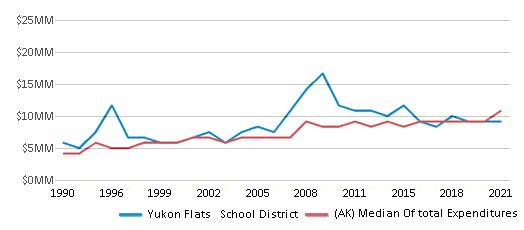
Revenue / Student
$50,584
$20,163
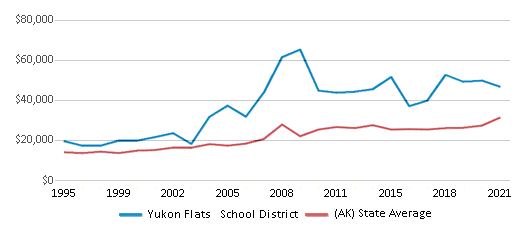
Spending / Student
$59,111
$21,240
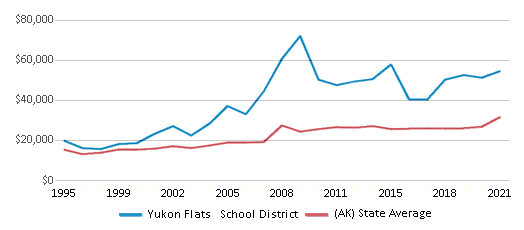
Best Yukon Flats School District Public Schools (2025)
School
(Math and Reading Proficiency)
(Math and Reading Proficiency)
Location
Grades
Students
Rank: #1 - 21. - 2.
Earla Hutchinson School
(Math: <50% | Reading: <50%)
Rank:
Rank:
10/
Top 10%10
161 Milepost Steese Hwy
Circle, AK 99733
(907) 773-1250
Circle, AK 99733
(907) 773-1250
Grades: PK-12
| 20 students
Rank: #1 - 21. - 2.
Tsuk Taih School
(Math: <50% | Reading: <50%)
Rank:
Rank:
10/
Top 10%10
#1 Marten Hill Dr
Chalkyitsik, AK 99788
(907) 848-8113
Chalkyitsik, AK 99788
(907) 848-8113
Grades: PK-12
| 12 students
Rank: #33.
Cruikshank School
(Math: <50% | Reading: <50% )
Rank:
Rank:
9/
Top 20%10
310 River Rd
Beaver, AK 99724
(907) 628-6313
Beaver, AK 99724
(907) 628-6313
Grades: PK-12
| 7 students
Rank: #4 - 54. - 5.
Arctic Village School
(Math: ≤20% | Reading: ≤20%)
Rank:
Rank:
5/
Bottom 50%10
305 Mountain St
Arctic Village, AK 99722
(907) 587-5211
Arctic Village, AK 99722
(907) 587-5211
Grades: PK-12
| 25 students
Rank: #4 - 54. - 5.
John Fredson School
(Math: ≤20% | Reading: ≤20%)
Rank:
Rank:
5/
Bottom 50%10
360 Chandalar Dr
Venetie, AK 99781
(907) 849-8415
Venetie, AK 99781
(907) 849-8415
Grades: PK-12
| 43 students
Rank: #66.
Fort Yukon School
(Math: ≤10% | Reading: ≤10%)
Rank:
Rank:
2/
Bottom 50%10
129 Main St
Fort Yukon, AK 99740
(907) 662-2352
Fort Yukon, AK 99740
(907) 662-2352
Grades: PK-12
| 83 students
Rank: n/an/a
123 Hill St
Fort Yukon, AK 99740
(907) 662-2515
Fort Yukon, AK 99740
(907) 662-2515
Grades: K-12
| n/a students
Frequently Asked Questions
How many schools belong to Yukon Flats School District?
Yukon Flats School District manages 7 public schools serving 190 students.
What is the rank of Yukon Flats School District?
Yukon Flats School District is ranked #34 out of 53 school districts in Alaska (bottom 50%) based off of combined math and reading proficiency testing data for the 2021-2022 school year. This district ranks in the top 20% of Alaska school districts for: Lowest student:teacher ratio (Top 1%)
What is the racial composition of students in Yukon Flats School District?
97% of Yukon Flats School District students are American Indian, and 3% of students are White.
What is the student/teacher ratio of Yukon Flats School District?
Yukon Flats School District has a student/teacher ratio of 8:1, which is lower than the Alaska state average of 18:1.
What is Yukon Flats School District's spending/student ratio?
The school district's spending/student of $59,111 is higher than the state median of $21,240. The school district spending/student has grown by 8% over four school years.
Recent Articles

Year-Round Or Traditional Schedule?
Which is more appropriate for your child? A year-round attendance schedule or traditional schedule? We look at the pros and cons.

Why You Should Encourage Your Child to Join a Sports Team
Participating in team sports has a great many benefits for children, there is no doubt. In this article you will learn what those benefits are.

White Students are Now the Minority in U.S. Public Schools
Increasing birth rates among immigrant families from Asia and Central and South America, combined with lower birth rates among white families, means that for the first time in history, public school students in the United States are majority-minority. This shift in demographics poses difficulties for schools as they work to accommodate children of varying language abilities and socio-economic backgrounds.





